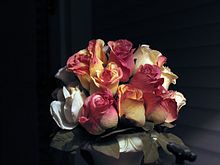
Back زهرة اصطناعية Arabic Изкуствено цвете Bulgarian Umělá rostlina Czech Kunstige blomster Danish Kunstblume German Flores artificiales Spanish گیاهان مصنوعی Persian Tekokukka Finnish Fleur artificielle French פרח מלאכותי HE
The examples and perspective in this article may not represent a full view of the subject. (November 2021) |


Artificial plants are imitations of natural plants used for commercial or residential decoration. They are sometimes made for scientific purposes (the collection of glass flowers at Harvard University, for example, illustrates the flora of the United States).[1] Artificial plants vary widely from mass-produced varieties that are distinguishable from real plants by casual observation to highly detailed botanical or artistic specimens.
Materials used in their manufacture have included painted linen and shavings of stained horn in ancient Egypt, gold and silver in ancient Rome, rice-paper in China, silkworm cocoons in Italy, colored feathers in South America, and wax and tinted shells.[1][2] Modern techniques involve carved or formed soap, nylon netting stretched over wire frames, ground clay, and mass-produced injection plastic mouldings. Polyester has been the main material for manufacturing artificial flowers since the 1970s. Most artificial flowers in the market nowadays are made of polyester fabric.[3]
- ^ a b One or more of the preceding sentences incorporates text from a publication now in the public domain: Chisholm, Hugh, ed. (1911). "Flowers, Artificial". Encyclopædia Britannica. Vol. 10 (11th ed.). Cambridge University Press. p. 573.
- ^ Cite error: The named reference
eawas invoked but never defined (see the help page). - ^ Gachman, Dina (11 May 2020). "No Natural Light? No Problem". The New York Times. Retrieved 31 July 2021.